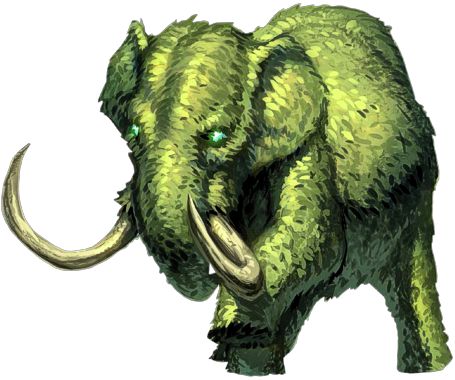

Book of Secrets

| Climate/Terrain: | Topiary Gardens or rarely in Woodlands |
|---|---|
| Frequency: | Very rare |
| Organization: | Group or Solitary |
| Activity Cycle: | Any |
| Diet: | None |
| Intelligence: | Low (5-7) |
| Treasure: | Nil |
| Alignment: | Neutral |
| No. Appearing: | 1d6 |
| Armor Class: | 8 |
| Movement: | See below |
| Hit Dice: | See below |
| THAC0: | As per HD |
| No. of Attacks: | See below |
| Damage/Attack: | See below |
| Special Attacks: | Poison |
| Special Defenses: | +1 or better to hit, ½ damage from blunt weapons, ¼ damage from slicing, surprise |
| Magic Resistance: | 35% |
| Size: | See below |
| Morale: | Fearless (20) |
| XP Value: | Varies |
Topiary golems are a rare magical construct found only in Renaissance-cultured domains. They appear as giant animals made of shrubbery, usually dogs, big cats, elephants, or dragons. During the spring and summer months they are light green, which gives them a form of camouflage (+3 bonus to surprise). During the fall and winter, they appear as a brown skeleton of naked branches. This still gives the golem a form of camouflage (+1 to surprise) in woodland settings.
Combat: Topiary golems attack as if they were the animals of their form. Thus dogs would rush up and bite, where lions would stalk their prey. Though each is unique, here are the basic stats of the more common forms:
| Type | MV | HD | # Att | Damage | Size |
|---|---|---|---|---|---|
| Dog | 15 | 4 | 1 | 2d4 | L (6’ long) |
| Lion | 21 | 6 | 3 | 1d4×2/1d8 | L (8’ long) |
| Elephant | 14 | 8 | 3 | 2d4×2/3d4+2 | L (12’ long) |
| Dragon* | 12, Fl 24 | 6 | 3 | 1d4+1×2/3d4 | L (10’ long, thin) |
Most wizards make their topiary golems out of plants with toxic sap. In these cases, with each successful attack there is a 15% chance that the victim must make a save vs. poison. Topiary golems may carry any kind of poison found in the Dungeon Master’s Guide. Unlike most other RAVENLOFT golems, topiaries are always under the control of their creator (or so their creators hope). If a golem is not trimmed for four weeks, it goes berserk, attempting to kill those who ignored it (usually the creator and master gardener). If it is somehow paralyzed and trimmed, it will return to normal.
Habitat/Society: Topiary golems are used to protect the garden and house of their creator. They can be given any simple orders (up to 15 words long). Most are placed next to where the wizard is growing spell components. The first known topiary golems in Ravenloft were made by an otherwise unknown wizard in Mordent. He used them more to keep superstitious people away than to protect his estate from would-be attackers. It is said that he has long since died and his creations still roam around his lands, killing those who attempt to enter his manor.
Topiary golems are also found on Gothic Earth. Originally encountered in a few sculptured gardens of Renaissance Europe in the sixteenth and seventeenth centuries, rumors of their resurgence have reached the ears of paranormal investigators in the late nineteenth century. They believe several gardens (modeled after the original European Renaissance gardens) on wealthy American industrialists’ estates and newly constructed resort hotels may be home to a modern variety of topiary golem in the Victorian Era.
Ecology: A wizard of 15th or greater level can create such a golem. He requires the spells wish, polymorph any object, and plant growth to give his creation “life”. It takes four years to grow the plant(s), then three weeks of spellcasting and trimming to form the golem. They do not cost much compared to other golems – only 3,000 gp/HD. If slain, their remains turn to dust which is worthless as spell components.
On Gothic Earth, it is believed that the modern topiary golems created in late nineteenth century America have been so created by adepts using a tome similar to The Frankenstein Papers (see the Masque of the Red Death adventure “Jigsaw” by Dan De Fazio and Christina A. Stiles in Dungeon Magazine #61). This tome is rumored to be written in Latin and penned by the original European creators.
